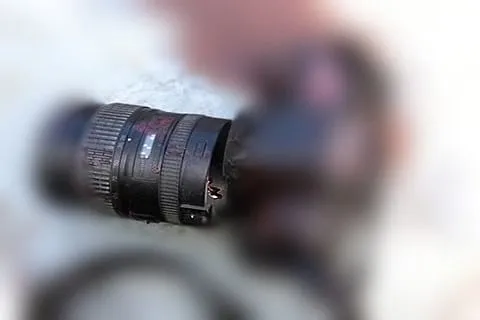It’s no less than a miracle that photojournalist Waseem Andrabi’s eyes are safe after metal pellets fired by government forces hit his face.
With six pellet holes on his face, Andrabi couldn’t have been luckier coming out of the site of a protest near the site of a firefight between militants and government forces in Shopian’s Heff village on Tuesday.
The incident became the latest to highlight the perils photojournalists, the frontline reporters in Kashmir are routinely exposed to.
“Clashes were going on near the encounter site. I along with five other photographers tried to move towards the forces’ side. Two among us were wearing bullet proof vests with ‘Press’ inscribed on them. Another was also wearing a helmet with ‘Press’ vividly printed on it. I also raised my camera as a signal to forces personnel,” said Andrabi, an award winning photojournalist with the Hindustan Times newspaper.
Then suddenly he heard a crackling sound.
“I felt itching on my face. I caressed my face with hand only to find blood. I found Nisar (another photojournalist) lying on the ground. After sometime, we gathered ourselves and got some medication from a local chemist, before going to a hospital,” said Andrabi, whose act of helping an injured CRPF man in Budgam last year was lauded by top brass of the paramilitary force.
The incident has once again rattled journalists in Kashmir, photojournalists in particular.
Mukhatar Khan, president of Kashmir Photojournalists Association (KPA), understands the pellet firing on his colleagues on Tuesday as a signal for scribes to not report the ground.
“Camera or writing pad is our identity. When it is not respected, what does it mean? They want to bar us from reporting the ground. Even though security top brass has assured us of action, but mere assurances won’t work,” said Khan, a photographer with the top global newswire Associated Press (AP).
Khan has himself been through such incidents in the past while on assignments in Kashmir.
He recalls how in 2004 he had a providential escape when government forces brought down a house in Tral using an Improvised Explosive Device (IED) after a gunfight with militants.
“It was a chance escape,” said Khan.
For Mehraj-u-din, a veteran photographer who has been covering Kashmir since 1979, photojournalists have always been at the receiving end in Kashmir.
Before 1990s, Mehraj said it was all about receiving an odd thrashing from angry protestors and intimidation from politicians, when protests over water scarcity and electricity shortage were more common in Kashmir.
“I remember clicking a photograph of then works minister Ghulam Mohammad Shah slapping a traffic police cop near Khayam cinema in the 80s,” said Mehraj, who has faced the ire of the powerful for showing them a mirror.
Mehraj recalls having a narrow escape in 1989, when he mistook a grenade for a stone.
“I was clicking pictures of a protest near Budshah Chowk and then there was an instant bang. I remember being rushed to SMHS hospital by a motorist in time. Otherwise, I would have died of blood loss,” said Mehraj.
Greater Kashmir photo chief, Habibullah Naqash has lost count of such instances when he narrowly escaped with his life.
A witness to the infamous parcel bomb explosion that left his colleague Mushtaq Ali dead, Naqash has tough memories as a photojournalist.
He escaped a deadly explosion in 2000 on Residency road in which 10 people including photojournalist Pradeep Bhatia lost their lives.
“There was a huge blast. It took me and other colleagues a minute to reach the spot since it is very close to Press Enclave. We couldn’t understand that it was a booby trap. I had just clicked a picture that everything turned black in front of my eyes,” said Naqash, recalling how he found himself in a hospital after the bang.
Similarly, the Indian Express photojournalist Shuaib Masoodi cannot forget the day he covered the attack on army convoy at Hyderpora in 2013.
“It is something indelible. I had gone in my car to cover the attack. After reporting back to my office, I went to a friend’s office at Jehangir Chowk. I had barely sat down at my friend’s office that there was commotion outside. I came down to find a Bomb Disposal Squad trying to blast off my car that I had parked below my friend’s office. Luckily, a police officer who knew me came to my rescue,” said Masoodi.
The words of police officer left Masoodi baffled.
“Look, your car number has been splashed that militants involved in the attack had used it. It is said that it is laden with explosives. Be careful!” Masoodi recalls the police officer telling him.
“It was traumatic. For next many days, I had to give explanations at every check point,” said Masoodi.
Javaid Dar, a photojournalist with Xinhua says, “We have to always face volatile situations from which normal people run away.”
“Be it protests or anything. We have to be there?” said Dar.
But, despite the dangers scores of young photojournalists continue to frame the conflict in Kashmir every day of their lives.






